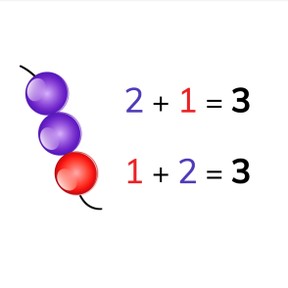
Addition to 10 swapping addends
I can add numbers up to 10 when the addends swap places.



8,000 schools use Gynzy
92,000 teachers use Gynzy
1,600,000 students use Gynzy
General
Students learn that when you add numbers to 10, that the addends can switch places without changing the sum.
Standards
CCSS.Math.Content.K.OA.A.1/2
Introduction
Start by decomposing numbers by using beads. Count the how many white beads there are, how many red beads, and how many there are total. Do the same with numbers using arrows. Students can also use blocks. You can ask students to decompose a few numbers that you say with the blocks that they have. An example: Decompose 5 into 4 and..... Next, ask two students to come to the front of the class and give them some erasers. For the first example, give 3 erasers to one student, and 2 erasers to the second. Ask them to calculate the total. 3+2 = 5. Now ask the students to exchange erasers. Ask students to calculate the total. Let them discover that the answer is still 5. The problem now is 2 + 3 = 5. You can repeat this a number of times (with other objects up to 10).
Development
Using an image, showing beads, demonstrate to students that if you swap the numbers in an addition problem, the sum remains the same. Show students an image of beads. Ask them how many beads they see of each color. There are 3 yellow beads and 1 orange bead. Or 1 orange, and 3 yellow. The problems that match tehse nubmers are 3+1=4 and 1+3=4. The numbers are swapped, but the number of beads stays the same. Repeat this multiple times with different beads and different amounts. Point at the beads when you first count them, and make sure to point at them again when you count the swapped addends to explicitly draw attention to the fact that the total amount stays the same. Ask students if they think one problem is easier than its swapped counterpart. Some students think 5=1 is easier than 1=5. Show the decomposition of 6 and show some addition problems that use those decompositions. Practice this with a selection of numbers. After practicing swapping addends in an addition problem with visual support of the beads, explain to students that the rule still applies if you only have the numbers without visual support. Practice swapping addends in addition problems with students doing problems without visual support.
Check that students understand adding numbers when addends swap places by asking the following questions:
- The number 6 decomposes into 2 and ?
- 2+4=6. How much is 4+2?
- Can you swap the addends in an addition problem?
- What happens with the sum of an addition problem when you swap the addends?
Guided practice
Students first do addition problems with visual support, then with number bonds, and finally without visual support. They must fill in the missing number from the problem.
Closing
Discuss with students, that it is important to be able to do this, so you can calculate quicker and easier. To close, do the addition problems shown on the interactive whiteboard as a class. Repeat with the last exercises.
Teaching tips
Students who have difficulty with this, can make use of manipulatives like MAB blocks (or a rekenrek). Have them decompose the number 8, for example, into 3+5. Have them set out the blocks and count how many there are together. Then swap the addends, so they work with 5+3.
Instruction materials
Erasers, blocks/manipulatives
The online teaching platform for interactive whiteboards and displays in schools
Save time building lessons
Manage the classroom more efficiently
Increase student engagement
Discover more!
About Gynzy
Gynzy is an online teaching platform for interactive whiteboards and displays in schools.
With a focus on elementary education, Gynzy’s Whiteboard, digital tools, and activities make it easy for teachers to save time building lessons, increase student engagement, and make classroom management more efficient.



